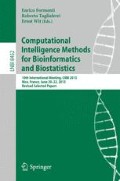Abstract
Below the influence of the mechanical cues and genetic expression, constraints underlying the developmental process play a key role in forms’ emergence. Theses constraints lead to cells’ differentiation and sometimes determine the directions of cells growth. To better understand these phenomena, we present in this paper our work focused primarily on a development of a mathematical model. A one which takes into account the co-evolution of cellular dynamics with it’s environment. To study the influence of the developmental constraints, we have developed algorithms to make and explore a base of genomes. The purpose of this exploration is first to check conditions under which specific genes are activated. Then, this exploration allows us to follow the conditions of emergence of some patterns that lead to a specific shape. From our model, we found a genome that can generate the French flag. With this French flag pattern and its genome starting, we addressed the following question: is there another genome in the simulated base that achieves the same shape, i.e. the French flag pattern?
Access this chapter
Tax calculation will be finalised at checkout
Purchases are for personal use only
Notes
- 1.
In biology, the vitellus is the energy reserve used by the embryo during its development.
- 2.
A eukaryote is an organism whose cells contain complex structures enclosed within membranes.
- 3.
Graphics Processing Unit.
References
Aubin, J.: Mutational and Morphological Analysis: Tools for Shape Regulation and Morphogenesis. Birkhauser, Boston (2000)
Aubin, J.-P.: Viability Theory. Birkhauser, Boston (1991)
Chevaillier, P., Bonneaud, S., Desmeulles, G., Redou, P.: Experimental study of agent population models with a specific attention to the discretization biases. In: Proceedings of the European Simulation and Modelling Conference (ESM’09), Leicester, UK, pp. 323–331 (2009)
Desmeulles, G., Querrec, G., Redou, P., Misery, L., Rodin, V., Tisseau, J.: The virtual reality applied to the biology understanding: the in virtuo experimentation. Expert Syst. Appl. 30(1), 82–92 (2006)
Doursat, R.: Organically grown architectures: creating decentralized, autonomous systems by embryomorphic engineering. In: Würtz, R.P. (ed.) Organic Computing. Springer, Heidelberg (2008)
Fronville, A., Harrouet, F., Desilles, A., De Loor, P.: Simulation tool for morphological analysis. In: Proceedings of the European Simulation and Modelling Conference (ESM’2010), Hasselt, Belgium, pp. 127–132 (2010)
Fronville, A., Sarr, A., Ballet, P., Rodin, V.: Mutational analysis-inspired algorithms for cells self-organization towards a dynamic under viability constraints. In: SASO 2012, 6th IEEE International Conference on Self-Adaptive and Self-Organizing Systems, Lyon, France, pp. 181–186 (2012)
Goldberg, A.D., Allis, C.D., Bernstein, E.: Epigenetics: a landscape takes shape. Cell 128, 635–638 (2007)
Henderson, J., Carter, D.: Mechanical induction in limb morphogenesis: the role of growth-generated strains and pressures. Bone 31(6), 645–653 (2002)
Kauffman, S.: The Origins of Order: Self-Organization and Selection in Evolution. Oxford University Press, New York (1993)
Lawson, B., Park, S.: Asynchronous time evolution in an artificial society mode. J. Artif. Soc. Soc. Simul. 3(1) (2000)
Lorenz, T.: Mutational Analysis - A Joint Framework for Cauchy Problems In and Beyond Vector Spaces. Springer, Berlin (2010)
Melani, C., Peyriéras, N., Mikula, K., Zanella, C., Campana, M., Rizzi, B., Veronesi, F., Sarti, A., Lombardot, B., Bourgine, P.: Cells tracking in the live zebrafish embryo. Conf. Proc. IEEE Eng. Med. Biol. Soc. 1, 1631–1634 (2007)
Müller, G., Newman, S.: Origination of Organismal Form: Beyond the Gene in Developmental and Evolutionary Biology. MIT Press, Cambridge (2003)
Pena, A.C.: Un modèle de développement artificiel pour la génération de structures cellulaires. Ph.D. thesis, Université de Toulouse, décembre 2007
Peyriéras, N.: Morphogénèse : L’origine des formes, chapter Morphogenèse animale, pp. 179–201. Belin, Paris (2006)
Reignier, P., Harrouet, F., Morvan, S., Tisseau, J., Duval, T.: ARéVi: a virtual reality multi-agent platform. In: Heudin, J.-C. (ed.) Virtual Worlds 98. LNCS (LNAI), vol. 1434, pp. 229–240. Springer, Heidelberg (1998)
Southern, J., Pitt-Francisb, J., Whiteleyb, J., Stokeleyc, D., Kobashid, H., Nobesa, R., Kadookad, Y., Gavaghan, D.: Multi-scale computational modelling in biology and physiology. Prog. Biophys. Mol. Biol. 96(9), 60–89 (2008)
Varela, F.: Principles of Biological Autonomy. North- Holland, New York (1979)
Waddington, C.: Organisers and Genes. CambridgeUniversity Press, Cambridge (1940)
Wolpert, L.: Positional information and the spatial pattern of cellular differentiation. J. Theor. Biol. 25, 1–47 (1969)
Author information
Authors and Affiliations
Corresponding author
Editor information
Editors and Affiliations
Rights and permissions
Copyright information
© 2014 Springer International Publishing Switzerland
About this paper
Cite this paper
Sarr, A., Fronville, A., Ballet, P., Rodin, V. (2014). French Flag Tracking by Morphogenetic Simulation Under Developmental Constraints. In: Formenti, E., Tagliaferri, R., Wit, E. (eds) Computational Intelligence Methods for Bioinformatics and Biostatistics. CIBB 2013. Lecture Notes in Computer Science(), vol 8452. Springer, Cham. https://doi.org/10.1007/978-3-319-09042-9_7
Download citation
DOI: https://doi.org/10.1007/978-3-319-09042-9_7
Published:
Publisher Name: Springer, Cham
Print ISBN: 978-3-319-09041-2
Online ISBN: 978-3-319-09042-9
eBook Packages: Computer ScienceComputer Science (R0)

